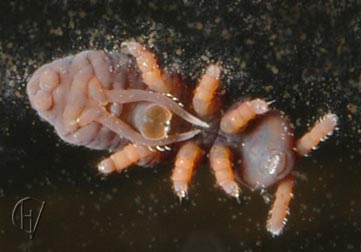back

A springtail looks a bit like a tiny grey Michelin Man: a wrinkled round body with short fat legs and antennae. There's still discussion on whether springtails belong to the insects or not, in any case they are placed in their own class: the Entognatha and, inside that class, in the order of the the Collembola. Most springtail species are inhabitants of moist places like dried-up pools, humid soil, tree-hollows and flowerstands. They can be found in all kinds of climates, from warm tropical forests to frozen glaciers. Just a few springtail species are living on the banks of ditches and lakes, but there they can be so numerous that they form a thin gray-blue carpet. They can jump and walk on the quiet watersurface of the borders. In Holland two species are present at the banks of ditches and ponds: the very common blue-gray Podura aquatica and the somewhat less common, white ball shaped Sminthurus. Both are tiny creatures, about one millimeter in size.

THE LITTLE FORK (furcula) lies folded forward under the belly. It consists of two
appendages attached to the tip of the abdomen that can be be hinged forward. It is always
extended backwards on the molted skins and on dead specimens. In rest the two teeth of the
fork are gripped by a sort of small latch, lying on the third segment. If a jump is started,
force is applied to the fork, then the latch is released. In that way the fork is slapped with
high speed against the surface, launching the springtail in the air some centimeters. Scaled
up to human size, we would be able to jump up to 30 or 40 meters! This spring like movement
has given the springtail it's English name. The Latin name Podura, coming from
Greek pous and oura, means "foot tail". I imagine the latch will cause
the shooting movement of the furcula, like the spring loaded metal gate in classic light
switches. Try this: make a fist and then stretch your index finger a few times. Now do the
same, but after first holding the top of the finger after the top of your thumb, you can then
make the movement a lot faster.
THE COLLOPHORE ("glue carrier") is a second tool of the little creature,
positioned under the first segment of the abdomen. On the picture left visible as two
light-brown discs in between the furcula. A tube shaped organ that ends in two smaller tubes,
and is stretched out by bloodpressure. It's function is not very clear, it is thought to
have a function in osmoregulation and excretion, but traditionally it was seen as an adhesive
organ, giving the springtails there scientific name Collembola, "glue
wedged". The springtail is water repellent, so it moves effortlessly over the
watersurface. If a breeze threatens to blow it away, it presses the collophore, which is
not water repellent, though the surface as a small anchor. After that, the collophore
is pulled in again and the springtail glides merrily on it's way.
The herds of springtails are sometimes harassed by a rove beetle, Stenus bimaculatus. This beetle has a long lower lip that may shoot out by blood pressure, at the end of the lip there are two adhesive discs. With this organ the beetle, like a miniature chameleon, can catch springtails. Surface bugs also have an appetite for springtails, like the watermeasurer and Microvelia. I don't know of European frogs eating springtails, but many tropical species have an appetite for them.